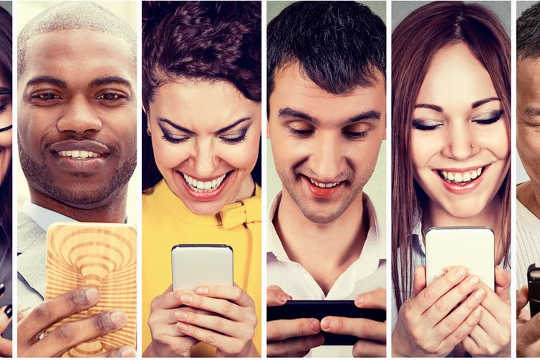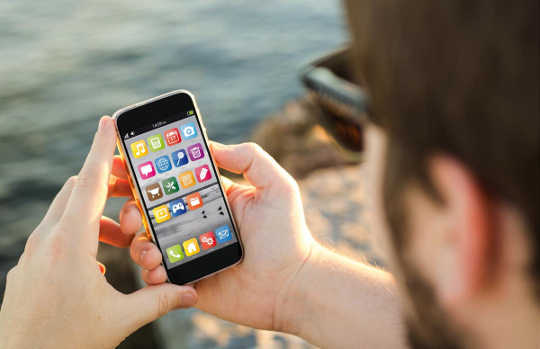 Pathdoc/Shutterstock.com
Pathdoc/Shutterstock.com
Has there ever been an invention so integral to our lives, and so intimate, as the smartphone? Yet they are slippery things. Smartphones are both a step change in the ability of human beings to communicate with each other and become informed, and a new point of vulnerability to penetration by the outside world. They are at once talismans of our freedom and connectivity and tokens of the corporations who collect our data and impinge on our privacy.
I’m an anthropologist, and I’m part of a team currently researching these issues. We’re trying to answer a very simple question: what is a smartphone? It may seem odd that a group of academics who specialise in the study of social relations should attempt this, but we are perhaps the only type of experts who can answer this question.
Why? Well, Apple makes the iPhone, Samsung the Galaxy; these are phones with the capacity to be smart. But what really makes them smart comes from below: from their appropriation by users. Very few people, if any, restrict themselves to the apps that come with their phone. Instead, each person creates a new configuration from additional apps and changed settings. AI and algorithms in turn facilitate the phone’s ability to learn from their specific individual usage. To know what the smartphone is requires observing how it has come into being through these processes.
We are taking a global perspective on the smartphone, investigating what kind of phone people create in places in Brazil, Cameroon, Chile, China, Ireland, Italy, Japan, East Jerusalem and Uganda. Our focus is on people at mid-life. We also study how the capacities created by smartphones might mitigate the loss of capacity associated with ill-health and observe how phones take on cultural as well as personal values.
To understand the smartphone, an analogy with the daemon in Philip Pullman’s Northern Lights novels may help. In the Northern Lights world, human beings have an animal avatar that can change in youth, but then settles into the species best reflecting their adult self: augmenting an aspect of their personality or profession. In Pullman’s latest novel, La Belle Sauvage, for example, the daemon Asta can become an owl in order to see better in the dark. The daemon is external yet integral. Even being a distance from one’s daemon can create a painful wrench.
{youtube}gNiiJ0JtBOQ{/youtube}
Similarly, we have a relationship to, as well as through, our phones, to others and back to ourselves. Our anxiety about a phone accidentally left at home may not just be the absence of a machine, but a temporary loss of part of ourselves.
Phone daemons
I’m carrying out my own part of the project in Ireland, where I have been observing how each phone becomes that particular person’s daemon. A retired fisherman’s phone, for example, expresses rugged and practical self-sufficiency – all usage must be justified by strict canons of function. Now his daughter is no longer in Australia, for example, Skype is seen as superfluous.
The iPhone of a 69-year-old professional woman, meanwhile, is a marvel. All her apps are in nested folders labelled finance, sports, news, and utilities. Each task, such as paying a utility bill, is scheduled in her calendar, which links to files on her notebook outlining each step of the procedure, relevant passwords and websites. Her phone has become a life manual of several hundred pages.
Then there is the phone dominated by seven apps all related to the owner’s passion for sailing. Or the caring phone devoted to helping a woman look after her 90-year-old mother with dementia; mobilising family care through WhatsApp, showing pictures of grandchildren through Facebook, using maps to reach a hospital appointment.
Typically, these people actively employ 25 to 30 different functions to craft their specific phones. Personalisation may involve downloading apps, but far more important is the adaptation of platforms such as WhatsApp and calendar. In this way, the phone becomes an avatar or daemon of that user.
Anthropomorphic machines
For more than a century, humanity has been fascinated by the development of the robot and its potential to realise our imagination of the anthropomorphic machine – that is, machines that look like or have the qualities of a human being. The robot is conceived to be a machine that becomes increasingly similar to us while remaining other. But the smartphone represents a more profound and advanced trajectory towards the anthropomorphic machine – one that proceeds through increasing intimacy.
Our concerns about robots have traditionally focused upon their appearance. We feel ambivalence about something that looks like us. By contrast, a smartphone looks not one iota like a human being. It has no arms and no legs. Instead, it achieves mobility through placement in trouser pockets or handbags. Anthropomorphism is advanced through these more prosthetic processes, the way the phone extends us, as well as its ability to transform the individual it belongs to.
The increasing intimacy of phones can also cause many problems. Those relating to the loss of privacy and control by corporations are familiar. Teaching phone usage to older people reveals the stupidity of phones. When asked to download an app, my students press an icon called downloads. They assume Google Play is for games. When asked to go on the internet, they don’t know if this means Samsung internet, Chrome, OK Google, or one called Internet. The young tell older people that smartphones are intuitive. They are quite wrong about that.
 What does your phone say about you? Georgejmclittle/Shutterstock.com
What does your phone say about you? Georgejmclittle/Shutterstock.com
Both these problems and the new capacities vary by region. Older people in Shanghai embrace the phone’s modernity and in a restaurant they may be the ones engrossed in their phones, while the young people chat directly to each other. In Japan, a country where people may hold funerals for material things, there was already a tradition of the daemon-like quality of objects and their intimacy that give these processes a distinct meaning.
To have an informed discussion about the use and consequences of smartphones we first need to know what they are, through examining the cultural and individual, as well as the technical, processes that make them smart.![]()
About The Author
Daniel Miller, Professor of Material Culture, UCL
This article is republished from The Conversation under a Creative Commons license. Read the original article.
Related Books
at InnerSelf Market and Amazon
























